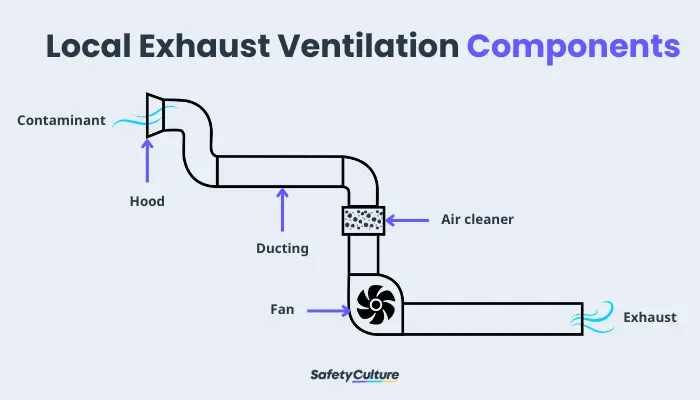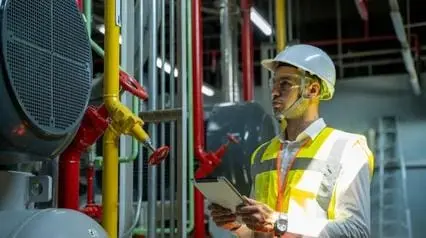What is Local Exhaust Ventilation (LEV)?
Local Exhaust Ventilation (LEV) is an engineering control system used to capture and remove airborne contaminants at their source before they can spread throughout the site. It’s an essential part of workplace health and safety programs, as it aims to protect workers from exposure to hazardous dust, mist, vapor, and fumes. LEV systems are used in various industries, such as manufacturing, construction, and healthcare.
Benefits
LEV systems offer numerous advantages. First, they improve indoor air quality by collecting, containing, and filtering harmful particulates at the place where they are emitted. This ventilation system is also instrumental in limiting exposure to hazardous substances (e.g., silica dust, nanomaterials), minimizing safety risks, and improving work environments for employees in high-risk settings (e.g., welding).
Moreover, a well-maintained LEV system allows for sufficient ventilation in a building. This measure helps decrease the risk of spreading airborne infections and avoid health hazards associated with poor air quality, such as:
- Headaches
- Dizziness
- Eye, nose, and throat irritation
- Asthma
- Legionnaires’ disease (from the Legionella bacterium)
- Other respiratory illnesses
- Heart disease
- Cancer (from exposure to Radon and other carcinogens)
How Does It Work?
A local exhaust ventilation system operates in a similar fashion to a household vacuum cleaner. It follows the following process:
- The hood collects dust, fume, vapor, and other contaminants at its emission point.
- The duct system sucks in the contaminated air and transports it inside the system.
- The filters attached to the LEV system clean the contained air before release.
- The fan pushes the air inside the LEV until it reaches the exhaust stack.
- Through the exhaust valve, the air gets pushed out of the system and into a safe place.
Local Exhaust Ventilation Components
An LEV system typically consists of the following elements:

Components of an LEV system
Hood
The hood, also called the inlet or closure, serves as the entry point for contaminated air in the LEV system. It takes a reverse funnel-like shape that gathers harmful particles straight from where it originates. This part comes in the following types, which usage will depend on the work to be performed and the substance to be collected:
- Enclosing – captures hazardous fumes and particles in enclosed spaces (e.g., glove boxes, spray booths)
- Capturing – utilizes airflow around the emission point to draw in contaminants outside the hood (e.g., fixed, moveable, on-tool)
Duct System
After getting pulled in by the hood, contaminants pass through a hollow-shaped channel called the duct system. This channel facilitates a seamless flow of air through the LEV system until it arrives at the exit. Ideally, it should have no sharp corners and be easily accessible for cleaning and maintenance.
Air Filter
Located in the interior of the LEV system, the air filter traps hazardous particles to clear out any impurities in the extracted air before it goes out of the system. While it adds a protective layer, it’s not a requirement, as some systems can work without the cleaning function.
For optimal performance, it’s best to choose a filter that works best against the contaminants you’re working with.
Fan
Considered a power source of the extraction process, the fan pushes the air from the ducts to the exhaust stack. By creating a negative pressure in the system, it ensures that hazardous substances are not released into the environment.
Exhaust Stack
The exhaust stack discharges air outside the LEV system. Also called an air discharge outlet, this valve is typically placed on the roof or outer wall of the building, away from air conditioning units and public spaces, to release extracted air in a safe manner.
LEV Installation and Maintenance Guidelines
For an LEV system to work at its optimal state, it must be installed correctly and maintained regularly. Here are some things to keep in mind when performing these processes:
Local Exhaust Ventilation Installation
Installing a local exhaust ventilation system is a complex process that requires the expertise of a competent and qualified professional. Proper installation is vital to ensure that the LEV system is effective in removing hazardous substances from the air.
The installation process typically involves the following steps:
- Identify the area to be ventilated and measure its size.
- Determine the size of the system by calculating the air flow rate required to effectively eliminate harmful particles and gases.
- Design the system to ensure its effectiveness in removing hazardous substances from the air.
- Select the appropriate fan, ducting, filters, and other components.
- Assemble all components and proceed with the installation process.
Local Exhaust Ventilation Maintenance
Aside from correct installation, an LEV system also requires regular maintenance to ensure that they are working properly and efficiently. This process involves scheduled maintenance checks, periodic inspections, and thorough testing.
First, periodic maintenance should be carried out to check for any signs of wear and tear and see if the system is operating correctly. It includes:
- Checking the filters, ducts, and fans for any blockages or damage
- Checking the system for any leaks or other issues that could affect its performance
- Gauging if the air flow rate is adequate using a dust lamp, anemometer, or smoke tracer
- Replacing filters and collection bags on a regular basis
- Cleaning the duct system and other components
Next to maintenance checks are regular inspections. In this procedure, a qualified professional examines the system for malfunctioning parts or potential problems and makes the necessary repairs or adjustments.
Create Your Own Local Exhaust Ventilation Inspection Checklist
Eliminate manual tasks and streamline your operations.
Get started for FREE
Lastly, local ventilation exhaust testing is performed to see if the system is meeting the required safety standards. It must be conducted on a regular basis—at least every 14 months in the UK, for example—to ensure that the system is operating safely and correctly.
Risks
Local exhaust ventilation systems may have several benefits, especially for workplace safety, but sometimes, they have drawbacks. Here are 5 common risks and challenges associated with LEV systems:
- Incorrectly installing the system can cause air to be drawn in from outside the building, making way for harmful particles to come inside.
- Local exhaust systems require frequent maintenance, which can take time to complete.
- Poorly maintained LEV systems can become a fire or explosion hazard.
- Improper and unsafe disposal of LEV emissions can harm the environment.
- LEV systems can be costly to establish and maintain, which can pose a problem to businesses on a tight budget.
Safety Regulations and Standards for LEV Systems
Local exhaust ventilation systems must meet specific laws and standards to safely and effectively function. They may vary depending on the country in which a business operates. This section walks you through some of the prominent regulations for LEV systems around the world.
United States
The Occupational Safety and Health Administration (OSHA) sets the standards for designing, installing, operating, and maintaining LEV systems. Here are the laws and regulations to refer to for LEVs in the US:
- OSHA Standard 1910.94 (Ventilation)
- OSHA Standard 1926.57 (Ventilation)
- American National Standard Fundamentals Governing the Design and Operation of Local Exhaust Systems (Z9.2-1960)
United Kingdom
In the United Kingdom, the Health and Safety Executive (HSE) is responsible for establishing guidance documents and regulations for local exhaust ventilation systems. Listed below are the laws and regulations that govern these systems:
- A Guide to Local Exhaust Ventilation (HSE HSG258)
- Health and Safety at Work etc. Act 1974
- Control of Substances Hazardous to Health 2002 (COSHH)
Australia
In Australia, the laws, regulations, and guidelines for LEV systems fall under the responsibility of Safe Work Australia. The following laws and standards generally apply to Australian territories:
- Model Work Health and Safety (WHS) Act
- Guidance on the Interpretation of Workplace Exposure Standards for Airborne Contaminants
- AS/NZS 4114:2020 (Spray painting booths, designated spray painting areas and paint mixing rooms)
- AS/NZS 2243.8:2014 (Safety in Laboratories – fume cupboards)
FAQs about Local Exhaust Ventilation
Ventilation systems come in three basic types:
- Natural ventilation – circulates natural air using windows, doors, and other openings
- Mechanical ventilation – utilizes fans and ducts to distribute air inside the building
- Hybrid ventilation – incorporates elements from natural and mechanical ventilation systems to facilitate airflow
Both general and local exhaust ventilation systems are used in industrial settings, but there’s a key difference between them.
General ventilation refers to systems that partially control indoor air particles, making it ideal for standard use. On the other hand, LEV works for locally-controlled zones, as it takes a more targeted approach to handle airborne contaminants.
LEV systems are typically used in areas where hazardous dust, fumes, and vapors could be present, such as the following:
- Chemical processing plants
- Paint and printing shops
- Welding operations
- Woodworking shops
- Laboratories
- Residential and commercial buildings
The price of local exhaust ventilation systems can range from $1,000 to $3,000, but this can vary depending on the LEV’s size and complexity. Generally, the cost will cover the equipment, installation, and maintenance. There may also be additional costs for services, such as permits, inspections, other regulatory requirements, and the disposal of hazardous materials.



